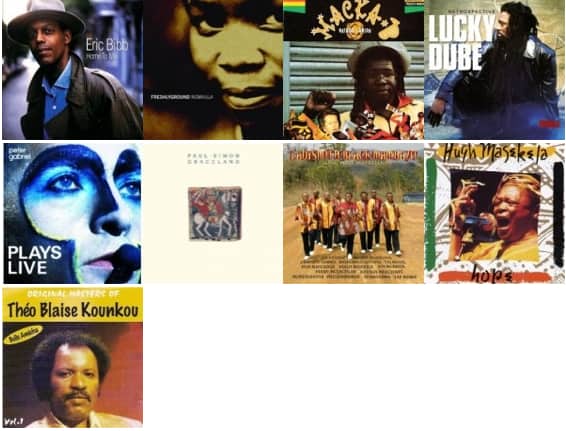December 26th, 2013
On December 5, 2013, Nelson Mandela, a beloved hero, a giant of history and one of the greatest visionary leaders of our time who fought to protect and promote human rights, passed away. As we come to the end of 2013, we would like to pay tribute to Nelson Mandela by sharing a blog from our frequent guest blogger, Tom Schanbel, who writes about the important role music played in shaping the history of the anti-apartheid movement in South Africa.
From all of us at ACEI, we wish you and yours a very happy holiday season.

Source: New Yorker, December 16, 2013
During my tenure as music director of KCRW (1979-1991), we had a dedicated African show (The African Beat) and often featured African music on other programs as well. We gathered South African music wherever we could: from Jo’Burg’s Kohinoor Store in Johannesburg, SA, from a woman named Di Brukin who brought us the latest SA grooves when KCRW was still on the John Adams Middle School Campus in 1981-1984. Roger Steffens, host of the popular Reggae Beat show (1979-1989), was sending Paul Simon the latest music from The Cockerel Boys, Kwa Thema High Jumers, Ladysmith Black Mambazo, and Boyoyo Boys on cassettes. Thus, inspiring Simon to record his epochal Graceland in 1985. We featured a lot of other Zulu Men’s Hostel Choirs too, such as the lesser known Abafana Baseqhudeni. Plus, lots of mbaqanga music–the infectious joy of Zulu jive. All this was during the period where Mandela was incarcerated in his small prison cell on Robben Island, a former leper colony and animal-quarantine center. During the 1980s, black South Africans were acutely aware of Nelson Mandela and the ANC (The African National Congress) that he led. And, music was a weapon against apartheid. We see this in the historic documentary Rhythm of Resistance, shot underground and clandestinely in the mid-1970s.

I once interviewed writer Rian Malan (the grandnephew of David Malan, a major definer of the doctrine of apartheid) on Morning Becomes Eclectic after his book My Traitor’s Heart was published. Rian Malan loved the exuberance of black South African culture, Zulu jive music and the joy it inspired. In this famous book he also wrote of the hatred and criminal horror inspired by apartheid. The irony of it all was not lost on me.
The cover image of the December 16th New Yorker magazine is of Mandela: a combination of both Tommy Smith’s unforgettable black power salute on the podium after winning gold at the 1968 Mexico City Olympics and the Statue of Liberty. Random fact, Tommy Smith later became a track coach at Santa Monica College. This music not only celebrates Mandela’s courage, leadership, and legacy: it is a celebration of life and the triumph of hope over despair.
(Note: Please also read the tribute to Nelson Mandela by Amnesty International in this link:
http://www.amnesty.org.uk/nelson-mandela-1918-2013#.UrCy_tJDuSo )

Tom Schnabel, M.A.
Chevalier de l’Ordre des Arts et des Lettres
Host of music program on radio for KCRW Sundays noon-2 p.m.
Blogs for KCRW
Author & Music educator, UCLA, SCIARC, currently doing music salons
www.tomschnabel.com

You can add Shakespeare to the music – Mandela’s favourite play was Julius Caesar and Zuma’s was Macbeth, both of which they studied. Bob Crew, Author of “Mandela: His Life and Legacy for South Africa and The World.” The hardcover version is listed on Amazon here: http://www.amazon.com/Mandela-Legacy-South-Africa-World/dp/1629143375/ref=tmm_hrd_title_0 and on Goodreads here: https://www.goodreads.com/book/show/19520182-mandela?from_search=true. Also on kindle and in the African bookshops.